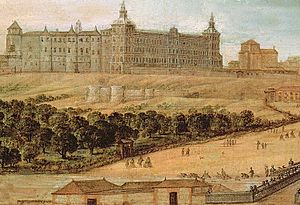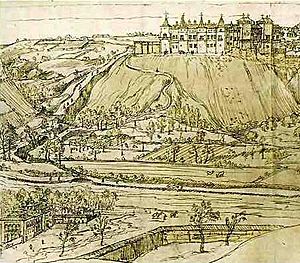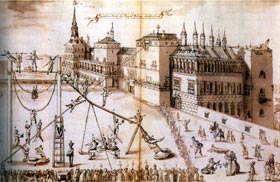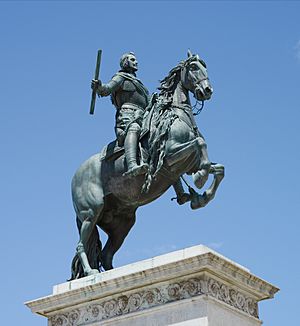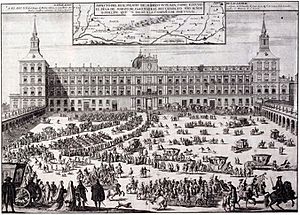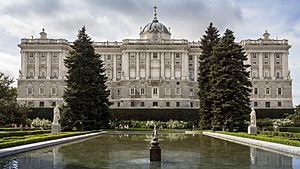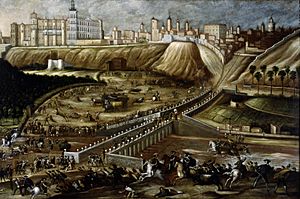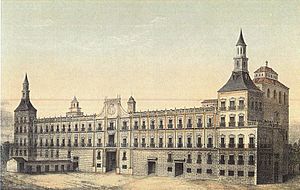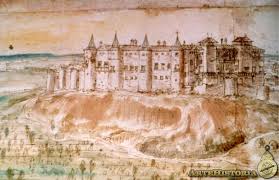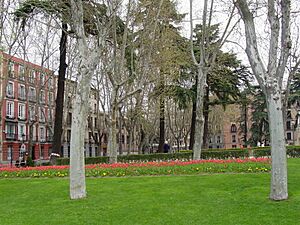Royal Alcázar of Madrid facts for kids
The Royal Alcázar of Madrid (in Spanish: Real Alcázar de Madrid) was a strong fortress in Madrid, Spain. It stood where the Royal Palace of Madrid is today. Muslims first built it in the late 800s. Over many centuries, it grew much larger. Around 1560, it became a royal palace. Madrid then became the capital of the Spanish Empire. Even as a palace, it kept its old Arabic name, Alcázar, which means "castle."
King Charles I ordered the first big expansion. This was finished in 1537. Later, the outside was built by architect Juan Gómez de Mora in 1636 for King Philip IV.
The Alcázar was famous for its art and unique design. It was home to the Spanish royal family and the royal court. But on Christmas Eve in 1734, a fire destroyed it during the rule of King Philip V. Many art treasures, including over 500 paintings, were lost. But some works, like Las Meninas by Velázquez, were saved.
Contents
History of the Alcázar
How the Alcázar Started
We have many old texts, drawings, and paintings of the Alcázar from 1530 until it burned down in 1734. But we don't have much information about its inside or its early history.
The first drawing of the Alcázar was made in 1534 by Cornelius Vermeyen. This was 30 years before Madrid became Spain's capital. The drawing shows a castle with two main parts. These parts might have been from the original Muslim fortress.
This first fortress was built by the Muslim leader Muhammad I of Córdoba between 860 and 880. It was the main part of the Islamic city of Mayrit. This walled area was about 4 hectares (10 acres). It included the castle, a mosque, and the governor's home.
Its location was very important. It was on a steep hill overlooking the River Manzanares. This made it key for defending Toledo from Christian attacks.
After Alfonso VI of León and Castile conquered Madrid in 1083, he needed a bigger fortress. He built a new one north of the old walls. So, the original Muslim fortress was not directly under the later royal palace. Over time, the old castle grew, but its first structure stayed inside. You can see this in old paintings. They show medieval towers on the western side, different from the southern side.
The Trastámara Family's Home
The Trastámara family used the Alcázar as a temporary home. By the late 1400s, it was a main fortress in the Crown of Castile. It was also where the royal court met. Because of its new use, it was called the "Royal Alcázar." This showed it was only for the kings and queens of Castile.
King Henry III added new towers. These made the building look more like a palace. His son, John II, built the Royal Chapel. He also added a new room called the Sala Rica (Rich Room) because it was so fancy. These additions made the old castle about 20 percent bigger.
Henry IV of Castile spent a lot of time at the Alcázar. His daughter, Joanna la Beltraneja, was born there in 1462. In 1476, her supporters were trapped in the Alcázar. This was because of fights with Queen Isabella I over the throne. The castle was badly damaged during this fight.
Charles V's Changes
The Royal Alcázar was damaged again during the Revolt of the Comuneros (1520-1522). This happened when Charles I was king. Because of the damage, Charles I decided to make it bigger. This was the first major building project for the Alcázar. He also wanted to make Madrid the capital, but this didn't happen until Philip II's time.
Historians say that Charles V wanted a royal home in Madrid. Instead of tearing down the old castle, he decided to use it as a base for a new palace. It kept the name Royal Alcázar of Madrid, even though it was no longer used for military defense.
Building started in 1537. Architects Luis de Vega and Alonso de Covarrubias led the work. They updated the old buildings around the King's Courtyard. Their most important work was building the new Queen's rooms around the Queen's Courtyard. The Tower of Charles V was built on one of the northern corners. These new parts doubled the size of the building.
The new design had clear Renaissance features. You could see them in the main staircase and both courtyards. These areas had arches and columns, letting light into the building. Charles V's expansion was the first big change to the Alcázar. Many more updates and redesigns followed until it was destroyed in the 1700s.
Philip II's Palace
Philip II was very interested in his father's building projects. As King, he kept them going. He turned the building into a true palace, especially after 1561. That's when he decided to make Madrid the permanent home of his court.
The King ordered his rooms and others to be updated. He paid special attention to their decoration. He hired tailors, glassmakers, carpenters, painters, and sculptors. Many of these skilled workers came from the Netherlands, Italy, and France. The work lasted from 1561 to 1598. Gaspar de la Vega was in charge at first.
The Golden Tower was the most important part built during this time. Architect Juan Bautista de Toledo oversaw its construction. This huge tower stood on the southwest side of the Alcázar. It had a pointed slate roof. Its design was like the corner towers of the El Escorial monastery, which was also being built then.
Philip II made the Royal Alcázar of Madrid a full royal palace. The middle part of the southern side became a place for ceremonies. The northern side was for servants. The western side was for the King's rooms, and the eastern side for the Queen's. Two large courtyards separated these areas. This layout stayed the same until the fire of 1734.
Philip II also built the Royal Armoury. It was torn down in 1894. Now, the crypt of Almudena Cathedral is in its place.
Philip III, Philip IV, and Charles II
By the end of Philip II's rule, the Alcázar still looked a bit odd. Its main southern side still had old medieval parts. These didn't match the new changes. The Golden Tower, added by the King, looked very different from the two old square medieval towers.
When Philip III became king, he focused on the southern side. He hired architect Francisco de Mora. The goal was to make the southern side match the Golden Tower. They also planned to redesign the Queen's rooms.
However, the work on the facade was finished by Juan Gómez de Mora, the first architect's nephew. He added new ideas in the popular Baroque style. This new design started in 1610 and finished in 1636. It lasted until the fire of 1734. The outdoor plaza was also completed under de Mora.
The building became brighter and more balanced. This was thanks to new windows and columns on two matching towers. Other sides were also updated, except for the western side. It kept its old medieval castle look.

Philip IV made the building look more even. But he didn't really like living there. He ordered a second palace, the Buen Retiro Palace, to be built. This palace also no longer exists. Walls were built east of the city, where the Retiro Park is now.
The work started by Philip III and finished by Philip IV continued under Charles II. He made small changes and updates. The Queen's Tower on the southeast side got a slate roof. It matched the Golden Tower built by Philip II. The plaza at the front of the southern side also got new rooms and hallways.
Philip V's Changes
Philip V became King of Spain on November 24, 1700. His crowning ceremony was in the palace's southern plaza. This plaza is now the Armoury Plaza.
The Alcázar was very plain. This was very different from the fancy Versailles in France, where he grew up. So, he focused on redecorating the inside of the palace.
The main rooms were redecorated in the French palace style. Queen Maria Luisa of Savoy was in charge of this work. She was helped by her lady-in-waiting, Marie Anne de La Trémoille.
Architect Teodoro Ardemans first led the redesign of the Alcázar's inside. Later, René Carlier took over.
The Great Fire of 1734
On December 24, 1734, a fire started at the Royal Alcázar of Madrid. The royal family was at the El Pardo Palace at the time. The fire likely started in the room of the court artist Jean Ranc. It spread very fast and could not be stopped. It burned for four days. It was so hot that silver objects melted. Other metal items and jewels had to be thrown away.
According to reports, the first alarm was raised just after midnight by a guard. But people ignored it at first because it was Christmas Eve. Monks from the San Gil monastery were the first to try to help. They tried to put out the fire and save people and valuables.
At first, the Alcázar's doors were kept closed. This was to stop people from stealing things. This meant people inside had little time to get out. It was a huge effort to save religious items from the Royal Chapel. They also saved money and jewels belonging to the royal family. A chest full of coins was thrown from a window. The jewels included the famous Pilgrim Pearl and the El Estanque diamond.
Saving paintings from the second floor was too hard. They were too big and in difficult spots. Some paintings were stuck to the walls. So, many paintings, like La Expulsión de los moriscos by Velázquez, were lost. Others, like Las Meninas (also by Velázquez), were saved. Workers took them out of their frames and threw them from windows. Luckily, some art had already been moved to the Buen Retiro Palace. This was to protect them during building work at the Alcázar. This saved them from the fire.
After the fire, the building was just ruins. The remaining walls were torn down because they were so damaged. In 1738, four years later, Philip V ordered the building of the current Royal Palace of Madrid. It took 30 years to build. Charles III was the first king to live there in 1764.
What the Alcázar Looked Like
Even with all the changes, the Alcázar never looked perfectly balanced. Visitors from France and Italy often said its outside walls were uneven. They also found the inside like a maze. Many private rooms were dark and had no windows for fresh air. This was a problem in Madrid's hot climate.
The western side was the most uneven. It faced the Manzanares River valley. So, it was less visible from Madrid's city area. But it was the first thing visitors saw when coming from the Segovia Bridge.
This side had the fewest changes. It kept the most medieval features. It was made entirely of stone with four towers. But some windows were made bigger than in the old fortress. The four towers had pointed slate roofs, like those on the Alcázar of Segovia. This made the building look less like a military fort.
The other sides were built with red brick and granite from Toledo. This gave the building the typical colors of Madrid's old buildings. These materials were easy to find nearby. Clay was plentiful by the Manzanares River, and granite came from the nearby Sierra de Guadarrama mountains.
The main entrance was on the southern side. This side was hard to redesign. It had two large square towers from medieval times. These towers broke up the long line of the facade. This line connected the Golden Tower (built by Philip II) with the Queen's Tower (built by Philip III and Philip IV).
With Juan Gómez de Mora's design, the towers were hidden. This made the building look more balanced. You can see this in Filippo Pallota's 1704 drawing. This architect also made the Golden Tower and the Queen's Tower look similar. He added a pyramid-shaped roof to the Queen's Tower, just like the Golden Tower.
The Royal Alcázar of Madrid had a rectangular shape. Its inside was divided by two large courtyards. The King's Courtyard was smaller and in the western part of the old castle. The Queen's Courtyard was on the other side. The Royal Chapel was built between the courtyards by King John II. For many years, the courtyards were open to the public. Markets were even held there.
The Alcázar's Art Collection
The Royal Alcázar had a huge art collection. When the fire happened, there were almost 2,000 paintings. About 500 of them were lost. The 1,000 paintings that were saved were kept in different places. These included the San Gil Convent and the Royal Armoury. Many paintings had already been moved to the Buen Retiro Palace during building work. This saved them from the fire.
One major painting lost was La Expulsión de los moriscos by Diego Velázquez. This painting helped him win a competition in 1627. The prize was a job at court, which was a big step in his career. It also allowed him to travel to Italy for the first time. He also painted a horse portrait of the King. Three of his four paintings about myths were also lost. Only Mercury & Argos was saved.
Several works by Peter Paul Rubens were lost in the fire. This included a horse portrait of Philip IV. The King had specially ordered it. It was proudly displayed in the Room of Mirrors. It hung across from the famous Titian painting, Charles V at Muhlberg.
The Uffizi Gallery in Florence has a good copy of the Rubens portrait. Another Rubens painting, El rapto de las Sabinas, was also lost. Twenty artworks that decorated the Octagonal Room were also destroyed.
Among the Titian pieces lost was the series The Twelve Caesars. These were in the Great Room. Today, they are known from copies and engravings. Two of his four Furias series were also lost. The other two are now in the Museo del Prado in Madrid. Many other valuable works by artists like Tintoretto, Paolo Veronese, Jusepe de Ribera, Hieronymus Bosch, Brueghel, Alonso Sánchez Coello, Van Dyck, El Greco, Annibale Carracci, Leonardo da Vinci, Guido Reni, Raphael, and Correggio were also destroyed.
Some sculptures that survived include the bronze Medici lions from the Room of Mirrors. Four of these are now in the throne room of the current Royal Palace of Madrid. The other eight are in the Museo del Prado.
Other Buildings Around the Alcázar
Changes to the Royal Alcázar also affected the area around it. Several buildings were added to its grounds. The Royal Stables were built south of the Alcázar. They included the Royal Armoury rooms. To the north and west were the Picadero plaza and the Gardens of the Prioress. These connected the palace to the Royal Monastery of the Incarnation. To the east, the House Treasury was built.
The House Treasury
This was a group of buildings for different services. It included offices and new kitchens. Work started in 1568 under Philip II. It was first planned as a separate building. But it became connected to the Alcázar so people could go directly between them.
In the 1600s, a walkway was built. It connected the House Treasury to the Royal Monastery of the Incarnation. This allowed royals to go from the Palace to the Monastery easily.
The House Treasury became home to the Royal Library (later the National Library). This was thanks to King Philip V. This building survived the 1734 fire. But King Joseph I ordered it torn down. He wanted to create a large plaza next to the eastern side of the Royal Palace of Madrid.
The old parts of the building were found in the 1900s. This happened during a redesign of the East Plaza in 1996. Even though they were historically important, these remains were destroyed.
The Royal Stables and Royal Armoury
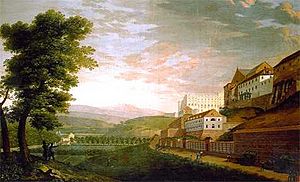
In 1553, King Philip II decided to build a complex for the Royal Stables. It was built across from the palace's southern plaza. This area is now where the crypt of the Almudena Cathedral is. The project was led by Gaspar de Vega. It lasted from 1556 to 1564, with later changes.
The building was rectangular. It had a long central area, 80 by 10 meters (262 by 33 feet). It had 37 columns that held up a vaulted roof. The horse troughs were on both sides of the corridor. The Royal Stables had three main fronts. The main one, with its granite arch, faced the Royal Alcázar. Another was on the side of the central corridor. The last one faced the palace plaza to the south. This side was called the Armoury Arch.
In 1563, the King ordered the Royal Armoury to be moved to the upper level. Before this, the Armoury was in Valladolid. This changed the first design, which had planned the upper level for stablehands. In 1567, sloping slate roofs were added. The complex ended up with three floors. The building was torn down in 1894. This was to make way for the new crypt of the Almudena Cathedral.
The Gardens of the Prioress
The Gardens (or Orchard) of the Prioress were created in the early 1600s. This was after the Royal Monastery of the Incarnation was founded in 1611. They were located north and west of the Royal Alcázar.
The monastery managed these gardens. They were where the Cabo Noval Gardens are today, within the East Plaza.
In 1809 and 1810, King Joseph I ordered the Gardens of the Prioress to be taken and destroyed. He also had buildings nearby torn down. He wanted to create a large plaza east of the Royal Palace. But this plan wasn't finished until Isabella II's reign. That's when the East Plaza was finally completed.
See also
 In Spanish: Real Alcázar de Madrid para niños
In Spanish: Real Alcázar de Madrid para niños
- List of missing landmarks in Spain
- History of Madrid
- Royal Convent of La Encarnación


